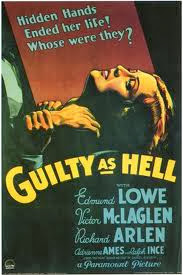Guilty as Hell. It's an eye-catcher of a title, is it not? -- and the only thing that originally piqued my interest. I didn't need to know the story before going in. I might not have even bothered with it had it gone by the title of the play it was based upon, Riddle Me This. As any Halloween merchant will affirm, hell sells.
The poster's tagline -- "Hidden hands ended her life! Whose were they?" -- -- turns out to be something of a ruse. You know from the first seconds who killed the lady in question (her name's Ruth, by the way); it was her husband, Dr. Tindal. Tindal strangled her (possibly for signing up for Obamacare) and framed her lover, Frank Marsh, for the crime. It's up to wisecracking reporter Russell Kirk to find the real killer.
 |
| Vera would look pretty hot if she didn't have that zombie vibe going on. |
 |
| I'd like to see a newspaper reporter try this on a New York police detective today. |
Guilty as Hell goes off in all kinds of tangents -- Russell falling hard for Vera; a gangster named Jack Reed getting hauled in as a material witness; a running gag involving a woman both Kirk and McKinley have been sleeping with -- leading up to Frank landing on death row. The prison scene features an early use of what would become a classic movie cliche. As Frank counts the hours before getting his neck stretched, a black prisoner sings a haunting spiritual. Well, kind of a spiritual. "The Lonesome Road" was something of a pop number, co-written and recorded by crooner Gene Austin in 1927. It was the go-to song when you wanted to feel all righteous without having to sit through a sermon. (Frank Sinatra, no saint he, turned it into a jazz standard in the '50s.)
 What really sets Guilty as Hell apart from other crime movies of its day is its look. Perhaps conscious of the script's stage origins, director Erle C. Kenton goes to town with the visuals effects. It isn't just that Guilty as Hell contains fluid camerawork and more wipes than the baby care aisle of a CVS. In its opening moment, we see Ruth's strangulation from her point of view and in the reflection of Tindal's glasses -- an unexpected ratcheting up of the creep factor still effective over 80 years later. Is it possible that Alfred Hitchcock remembered this startling effect when shooting a similar scene for Strangers on a Train 20 years later? Or am I talking through my felt fedora with wild, idiot abandon as usual? I think we know the answer to that one.
What really sets Guilty as Hell apart from other crime movies of its day is its look. Perhaps conscious of the script's stage origins, director Erle C. Kenton goes to town with the visuals effects. It isn't just that Guilty as Hell contains fluid camerawork and more wipes than the baby care aisle of a CVS. In its opening moment, we see Ruth's strangulation from her point of view and in the reflection of Tindal's glasses -- an unexpected ratcheting up of the creep factor still effective over 80 years later. Is it possible that Alfred Hitchcock remembered this startling effect when shooting a similar scene for Strangers on a Train 20 years later? Or am I talking through my felt fedora with wild, idiot abandon as usual? I think we know the answer to that one. A scene in McKinley's office features a whole mess of reverse POV shots during a heated argument among several characters. This is especially unnerving when being yelled at by McKinley, played by the decidedly undishy Victor McLaglen, and Adrienne Ames as Vera Marsh, who seems to be suffering from a textbook case of exophthalmos. Lady, see an ophthalmologist, you're scaring the children!
A scene in McKinley's office features a whole mess of reverse POV shots during a heated argument among several characters. This is especially unnerving when being yelled at by McKinley, played by the decidedly undishy Victor McLaglen, and Adrienne Ames as Vera Marsh, who seems to be suffering from a textbook case of exophthalmos. Lady, see an ophthalmologist, you're scaring the children! |
| "No, point toward the camera!" |
But one thing left me puzzled. Guilty as Hell appears to located in New York... except the capitol building is shown as being a few blocks from McKinley's office, which would make it Albany. Yet Jack Reed is hiding out in "the Heights" -- which made me think of Brooklyn. But the telephone exchange seen in a close-up of a phone book is Madison, as in Avenue, as in Manhattan. Googling the phone number today -- MA6-2020 -- will take you to businesses in Queens, Los Angeles and Phoenix...
You think me obsessive? Well, there's only one way I can possibly plead, your honor:
********************




No comments:
Post a Comment